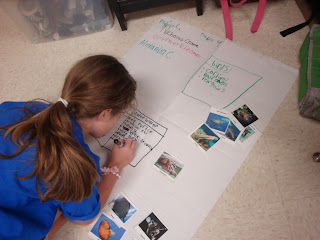Our world abounds with countless and intriguing animals. They need oxygen to breathe, food to eat, water to drink, a shelter to live in, and they need to be able to produce offspring. Some of the animals have backbones (vertebrates) and some do not (invertebrates).
Some animals breathe oxygen with lungs, some with gills, and others, like sea jellies, through their skin. Birds and mammals are warm blooded while other animals are cold blooded. Some animals have live birth, yet others lay eggs for their young to hatch.They can be carnivores, herbivores, or omnivores, and habitats of all kinds are their homes.
others, like sea jellies, through their skin. Birds and mammals are warm blooded while other animals are cold blooded. Some animals have live birth, yet others lay eggs for their young to hatch.They can be carnivores, herbivores, or omnivores, and habitats of all kinds are their homes.
 others, like sea jellies, through their skin. Birds and mammals are warm blooded while other animals are cold blooded. Some animals have live birth, yet others lay eggs for their young to hatch.They can be carnivores, herbivores, or omnivores, and habitats of all kinds are their homes.
others, like sea jellies, through their skin. Birds and mammals are warm blooded while other animals are cold blooded. Some animals have live birth, yet others lay eggs for their young to hatch.They can be carnivores, herbivores, or omnivores, and habitats of all kinds are their homes. Fascinated with animals, our young scientists have been exploring this diverse world of captivating animals. Throughout the unit, they have been asking, pondering, and answering questions.
In what ways can animals be grouped?
How can we sort animals?
How can we classify vertebrates?
How can we classify invertebrates?
How do animals adapt to survive?
How does an animal's body coloring help it survive?
How do animals in Florida's Everglades National Park respond to changing seasons?
To explore, they have created lists of animals and sorted them into groups based on common characteristics. They have sorted vertebrate animal cards into groups of mammals, birds, reptiles, amphibians, and fish. They have sorted invertebrate animal cards into groups of sea jellies, worms, mollusks, and arthropods. Furthermore, they've discussed, in great depth, the animal adaptations that help them to survive in the places where they live.
Some animals, for example, have protective adaptations like camouflage, armor, mimicry, and poison, while others have behavioral adaptations like the instinct to migrate and hibernate to survive the winter. In addition, animals have physical adaptations that help them survive. Birds, for example, depending on the food they eat, have different kinds of beaks. Cardinals have short, strong bills to pick up and crush seeds. The pelican, on the other hand, has a long, pouched bill that helps it swoop down and pick up fish.
From the very first introduction of this unit, our students took a special interest. To promote this enthusiasm, we designed an independent study for students so they could explore an animal and a project of their choice. We created a menu of options, stocked the classroom with reference materials and texts for research, and gave them a rubric to guide their exploration. Each day, the students come to the classroom excited to get to work and they have been self-directed in their learning. Stay tuned. We can't wait to share some of their polished products with you when they are finished.













That is so cooooooooooooooooooooool
ReplyDeleteJordan
Shafer
I love the picchrs. They are so cooooooool
ReplyDeleteJordan
Shafer
Working with animals are fun!! Yuri
ReplyDeleteSpeaking of animals I loved doing the animal project!
ReplyDeleteWorking with animals are fun! And also we get to learn much more than we knowed at the beginning!
ReplyDeleteYuri
i like science.It's sad that we are done with animal unit.I really like the animal unit!!!!. AND the most think i like is animal project that was SO SO SO FUN I LIKE IT!!!!!!!!!!!!!!!!!!!!
ReplyDeletefrom: maritza and my sister surey
I LOVED the animal project.
ReplyDelete-ALEXANDRA
Jack loved researching and creating a multi-media presentation about whales. What a powerful learning experience!
ReplyDeleteAngela Phillips
i love the progegts that we did they wer cccccccccccccccccccoooooooooooooooooooool
ReplyDeleteI love the pictures. They are very cool
ReplyDeleteLove Jordan Shafer